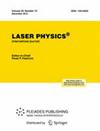Modulating dual-wavelength optical fiber vector solitons
IF 1.1
4区 物理与天体物理
Q4 OPTICS
引用次数: 0
Abstract
Abstract Optical fiber vector solitons have potential applications in the field of high-capacity optical fiber communications and have been widely explored in recent years. Here, we theoretically modulate dual-wavelength optical fiber vector solitons in an optical fiber system at a wavelength regime of 1 μ m while considering the influence of group velocity dispersion. When the input dual-wavelength optical fiber vector solitons have the same two central wavelengths of 1057 nm and 1063 nm in orthogonal directions, the output modulated optical fiber vector solitons’ pulse shapes and optical spectra will maintain their peak intensities upon the change of the projection angle. When the two orthogonal central wavelengths of the input dual-wavelength optical fiber vector solitons are slightly different (1056 nm and 1062 nm in one polarization direction, 1058 nm and 1064 nm in the other direction), dual-peak pulse shapes appear and are accompanied by different wavelength peak intensities when the propagation distance increases. Our simulation results examine the out-cavity modulation of dual-wavelength optical fiber vector solitons and can be expanded to multi-wavelength optical fiber vector solitons’ modulation.调制双波长光纤矢量孤子
摘要光纤矢量孤子在大容量光纤通信领域具有潜在的应用前景,近年来得到了广泛的研究。本文在考虑群速度色散影响的情况下,从理论上对光纤系统中波长为1 μ m的双波长光纤矢量孤子进行调制。当输入双波长光纤矢量孤子在正交方向上具有相同的1057 nm和1063 nm两个中心波长时,随着投影角度的变化,输出调制光纤矢量孤子的脉冲形状和光谱将保持其峰值强度。当输入双波长光纤矢量孤子的两个正交中心波长略有不同(一个偏振方向为1056 nm和1062 nm,另一个方向为1058 nm和1064 nm)时,随着传播距离的增加,出现双峰脉冲形状,并伴有不同的波长峰强度。我们的仿真结果研究了双波长光纤矢量孤子的腔外调制,并可以扩展到多波长光纤矢量孤子的调制。
本文章由计算机程序翻译,如有差异,请以英文原文为准。
求助全文
约1分钟内获得全文
求助全文
来源期刊

Laser Physics
物理-光学
CiteScore
2.60
自引率
8.30%
发文量
127
审稿时长
2.2 months
期刊介绍:
Laser Physics offers a comprehensive view of theoretical and experimental laser research and applications. Articles cover every aspect of modern laser physics and quantum electronics, emphasizing physical effects in various media (solid, gaseous, liquid) leading to the generation of laser radiation; peculiarities of propagation of laser radiation; problems involving impact of laser radiation on various substances and the emerging physical effects, including coherent ones; the applied use of lasers and laser spectroscopy; the processing and storage of information; and more.
The full list of subject areas covered is as follows:
-physics of lasers-
fibre optics and fibre lasers-
quantum optics and quantum information science-
ultrafast optics and strong-field physics-
nonlinear optics-
physics of cold trapped atoms-
laser methods in chemistry, biology, medicine and ecology-
laser spectroscopy-
novel laser materials and lasers-
optics of nanomaterials-
interaction of laser radiation with matter-
laser interaction with solids-
photonics
 求助内容:
求助内容: 应助结果提醒方式:
应助结果提醒方式:


